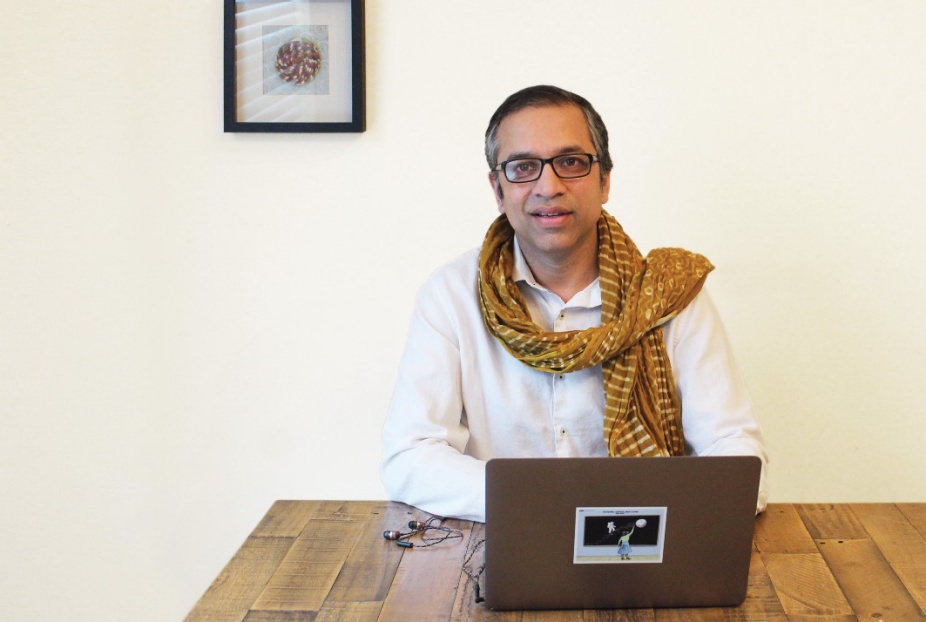
OFFICE HOURS FACULTY PROFILE
Meet me in my (ad-hoc) office with Sameer Honwad
BY MICHELLE KEARNS
The sudden, virus-provoked exit from campus workspaces this spring led Sameer Honwad to work from his home, repurposing rooms into office spaces. A spot in his bedroom now holds his computer. Books pile by the couch where he goes to read. The kitchen table, with a window near and a wall of art, makes for a good Zoom backdrop.
“I usually work there in the mornings,” he said. “It’s a nice spot.”
Honwad, an assistant professor in the Department of Learning and Instruction and a native of India, specializes in learning sciences and storytelling as a learning and teaching tool.
His story-based research projects include a developing museum of climate-change stories in Bhutan and working with young people in Idaho’s Coeur d’Alene tribe to create podcasts about environmental concerns.
Once the pandemic hit, a pilot version of a new project launched with Ryan Rish, a fellow assistant professor of learning and instruction, exploring the graphic novel as a teaching tool. The ease of distance meeting by Zoom helped things move more quickly. It took a few weeks, instead of a few months, for Honwad and three graduate students to use their connections to recruit 14 high school volunteers in Buffalo, New Orleans, Chicago, Mexico and India. They divided into groups and met for three weeks by Zoom to develop comics related to the pandemic and its effect on people’s lives.
The result: Compelling stories with superheroes and regular people grappling with COVID-19 dilemmas like how to keep families safe and reckon with the disparities that come with privilege. “All 14 of them are beautiful,” Honwad said of stories students presented in a Zoom call at the end of July. Now they are applying for a National Science Foundation grant to do the project again and train teachers to use graphic novel assignments. “COVID is a complex problem. If we want kids to learn about complexity, we have to teach about complexity … Storytelling allows us to think about complexity in a way in which complexity is not lost.” Read the students’ work at www.we-said.org.
In the photo:
Hanging on the wall is a coaster made of woven, colored cardboard was too lovely to use so Honwad framed it. Made by a woman artisan in India, it is a reminder of the beginnings of his career, 15 years ago, when he worked with two Himalayan village communities training young people to video interview parents and grandparents about the water shortage and how to address it.
Earbuds rest on his kitchen table. A casual, $25 purchase used to listen on Zoom and help him focus as he works.
“Now they’ve become an integral part of my life.”
He wears a scarf from his mother, who lives in India, is one of many in his collection from close family and friends. “I kind of steal their scarves,” he said. “All of my scarves are scarves which have sentimental value.”
A laptop sticker tribute to Katherine Johnson, the Black NASA mathematician portrayed in the movie “Hidden Figures,” who died this year. The drawing shows an astronaut stepping up stairs made from her chalkboard calculations. When Honwad spotted the editorial cartoon by the San Diego Union-Tribune’s Steve Breen, he converted it into a sticker. He likes to have art on his computer that connects to his work and his interest in theories that capture the experience of people of color. “Last year when I picked the sticker, I was reading a lot of Black feminist pedagogies and I was thinking more about, ‘How do you move away from whiteness?’”
- Access and Equity
- Cultural Studies; Diversity
Cognition - Environmental Education
- Design and Analysis of
Longitudinal Research - Gender, Culture and Equity
- Global Issues; Design Experiments
- International Education
- Race, Inequality and Education
- Learning Communities
- Learning Design; Science Education
- Problem-Based Learning;
Research Design